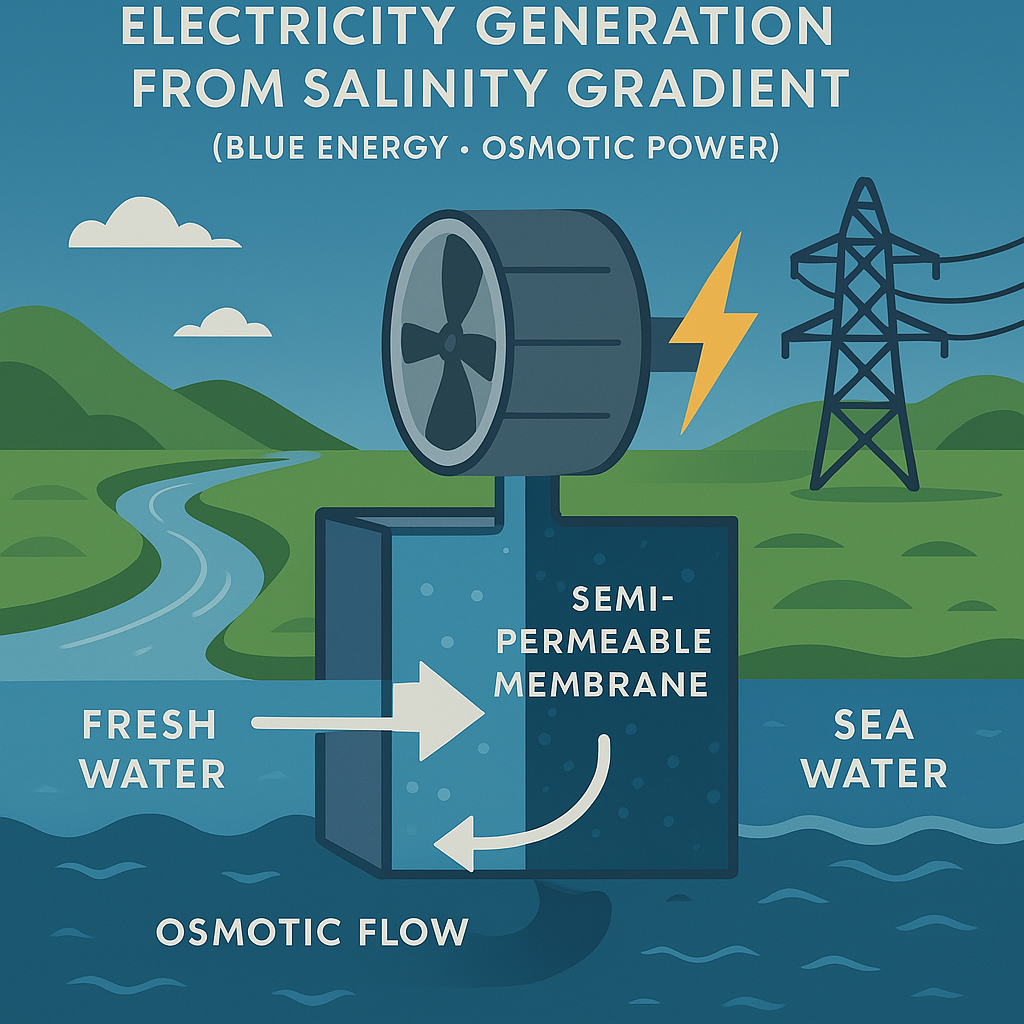
Comprehensive Report: Electricity Generation from Salinity Gradient (Blue Energy)
1. Introduction
Blue Energy, also known as salinity gradient power, represents an innovative and sustainable form of renewable energy derived from the salinity differential between two water bodies, typically where freshwater rivers converge with saline seawater. This naturally occurring phenomenon, prevalent at estuarine environments worldwide, offers a largely untapped resource for clean energy production. As global demand for renewable energy intensifies, Blue Energy emerges as a promising solution due to its abundance and environmental compatibility.
2. Working Principle
The generation of Blue Energy relies on the osmotic pressure differential created by salinity gradients. When freshwater and saltwater are separated by a semi-permeable membrane, water molecules spontaneously migrate from the freshwater side (low salinity) to the saltwater side (high salinity) in an attempt to equilibrate the concentration gradient. This osmotic flow generates pressure, which can be harnessed to drive a turbine and produce electrical energy. The process leverages a natural physical mechanism, making it both renewable and predictable.
3. Key Technologies
a. Pressure Retarded Osmosis (PRO)
PRO utilizes the osmotic flow of water through a semi-permeable membrane to create hydraulic pressure on the saltwater side. This pressure is subsequently released through a turbine to generate electricity. PRO is particularly effective in high-volume, low-pressure environments, making it suitable for large-scale estuarine applications.
b. Reverse Electrodialysis (RED)
RED employs a stack of alternating cation and anion exchange membranes to facilitate ion migration from high-salinity to low-salinity solutions. This ion movement generates an electrochemical potential difference, which can be converted into electrical energy. RED systems are modular and scalable, offering flexibility for various operational contexts.
c. Capacitive Mixing (CapMix)
CapMix exploits the electrochemical potential differences between freshwater and saltwater using carbon electrodes. As water salinity changes, charge accumulates on the electrodes, producing an electric current. While promising, CapMix remains in the experimental stage, requiring further development for commercial viability.
4. Advantages
- Renewability: The energy is derived from the continuous flow of rivers into seas, ensuring a perpetual resource.
- Environmental Sustainability: The process produces no greenhouse gas emissions and has a minimal ecological footprint compared to fossil fuel-based systems.
- Predictability: Unlike solar or wind energy, which are weather-dependent, salinity gradients in estuaries provide a stable and consistent energy source.
- Global Potential: Estimates suggest a worldwide capacity of 1 to 2 terawatts, sufficient to meet the electricity needs of millions of households.
5. Challenges
- Membrane Costs: High-quality semi-permeable membranes, essential for PRO and RED, remain expensive to produce and replace.
- Membrane Fouling: Accumulation of organic matter, salts, and biofouling on membranes reduces operational efficiency and increases maintenance costs.
- Engineering Complexity: Integrating Blue Energy systems with existing water infrastructure while adhering to environmental regulations poses significant design challenges.
- Energy Efficiency: Current conversion efficiencies lag behind those of wind and solar technologies, though ongoing research aims to close this gap.
6. Use Cases and Pilot Projects
Blue Energy technologies have been tested in various pilot projects globally, demonstrating their practical feasibility:
- Statkraft (Norway): In 2009, Statkraft launched one of the world’s first PRO-based Blue Energy plants, showcasing the technology’s potential in a real-world setting.
- WETSUS (Netherlands): This research institute has advanced RED technologies and explored hybrid systems combining salinity gradient power with other renewables.
- International Efforts: Countries such as Israel, Japan, and the United States are investigating Blue Energy for applications in sustainable desalination and coastal energy supply, leveraging their extensive coastlines and freshwater resources.
7. Future Outlook
The future of Blue Energy is closely tied to advancements in materials science, particularly in the development of cost-effective, durable, and fouling-resistant membranes. Innovations in nanotechnology and membrane engineering are expected to enhance energy conversion efficiencies, making Blue Energy increasingly competitive. Coastal regions and island nations with abundant freshwater inflows and access to seawater stand to benefit significantly, potentially achieving energy independence through this sustainable resource. As global investment in renewable energy grows, Blue Energy could emerge as a vital component of the transition to a low-carbon energy future.
8. Conclusion
Electricity generation from salinity gradients offers a clean, renewable, and reliable energy source with substantial long-term potential. While challenges related to cost, efficiency, and scalability remain, continued research and technological innovation are steadily addressing these barriers. With strategic investments in membrane technologies and system integration, Blue Energy has the capacity to become a competitive and integral part of the global renewable energy portfolio, contributing to a sustainable and resilient energy landscape.